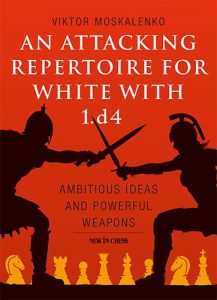An Attacking Repertoire for White with 1.d4 : Viktor Moskalenko

“Half the variations which are calculated in a tournament game turn out to be completely superfluous. Unfortunately, no one knows in advance which half..” – Jan Timman
The value for any practising chess player of a coherent opening repertoire when playing with the white pieces is key to success, enjoyment and efficient use of study time. Books with “Opening Repertoire” in the title are many and varied and we were intrigued to what the emphasis in this latest book from New in Chess would be.
From the books rear cover :
Viktor Moskalenko (1960) is an International Grandmaster and a FIDE Senior Trainer. The former Ukrainian champion’s recent books include The Even More Flexible French, The Wonderful Winawer, Training with Moska and The Fabulous Budapest Gambit.

So, what is An Attacking Repertoire for White with 1.d4 about ?
Up front one factor worth noting is that Moskalenko is advocating a repertoire based around the classical move order approach to playing the “Queen’s Gambit”, viz, 1 . d4, 2.c4 and 3. Nc3 rather than say 1. d4, 2.Nf3, 3.c4 which is, nonetheless, increasing in popularity. Some lines simply do not transpose of course so please bear that in mind !
The author has identified 14 defences employed by Black and offers lines for White against all of these. The variations given attention (and the order in which they are presented ) are :
- King’s Indian Defence : Four Pawns Attack
- Modern Benoni Defence : Taimanov Attack
- Snake Benoni (a fairly rare beast at club level and good to see it discussed therefore)
- Indo-Benoni which includes the Schmid Benoni & Czech Benoni
- Benko & Volga Gambit
- Grünfeld Defence
- Nimzo Indian Defence
- Slav Defence : Exchange Variation
- Queen’s Gambit Accepted
- Queen’s Gambit Declined : Triangle Variation
- Queen’s Gambit Declined : Exchange Variation
- Baltic Defence
- Chigorin Defence
- Albin Counter Gambit
For each of these chapters there is a theory / instructional section containing the recommended line, analysis and variations followed by a separate section of illustrative games from modern practise. Many of these 106 games are the authors own with insightful, deep notes explaining his thought processes.
For all fourteen chapters the emphasis of the author’s recommendations is on “active play supported by a powerful pawn centre” and this bears out when exploring the various recommendations.
Ideas featuring an early f3 (hence our comment about the Nf3 move order earlier!) appear frequently with the exceptions of the slightly surprising Exchange Slav and the Queen’s Gambit Accepted. recommendations. However, the latter pair do use active piece play lines (with an early Nf3 in the QGA).
The most interesting bonus is when one investigates the games section that is associated with each of the chapters. There is generous use of six clear symbols designating something special about various lines as follows :
- TRICK : hidden tactics and some tricky ideas, e.g. traps you can set and pitfalls you have to avoid.
- PUZZLE : possible transpositions, move order subtleties, curiosities and rare lines.
- WEAPON : the best lines to choose; strong or surprising options for both attack and defence, which deserve attention.
- PLAN : the main ideas for one of the sides in the next phase of the game.
- STATISTICS : winning percentages for a line for either side / player.
- KEEP IN MIND : here, fundamental ideas for either side are given.
An example from game 66 in the Exchange Slav chapter :
Black has played 11…Na5
12. Kf2
KEEP IN MIND : The king’s move is included in White’s plan, but it is more accurate to play h2-h4 or Ng3 first :
WEAPON / TRICK : For instance , 12.h4!? Nc4 13. Qc2!? b5 14. b3!? (with initiative) (14. Qb1 Khairullin-Kapnisis, Budva 2009) 14…b4? 15 Nxd5!+-;
WEAPON : Or 12. Ng3 !?
analysis diagram
12…Bc6 (12…h6 13 h4.!?) 13.g5!? Nd7 14.h4 Be7 15.Kf2! b5 (Moskalenko – Alono Rosell, Catalonia tt 2013) 16.Nce2!
Possibly the only disappointing recommendation is that of the use of the Exchange Slav to take on both the Slav and the Semi-Slav family. Recommending more ambitious lines for White would have increased the size of the book substantially and also the learning workload for the student : sometimes a line in the sand has to be drawn !
Reviewers usually like to point out material that they believe has been omitted and we will not disappoint you ! Chapters (we believe) should have been included are treatments of :
- The Queen’s Indian Defence (the most surprising omission of all)
- The Old Indian Defence (quite a rare bird of course)
- The Dutch Defence (see below*)
- Queen’s Gambit : Tarrasch Defence (popular at club level)
*In fairness to Moskalenko he refers readers to his previously (2014) New in Chess published The Diamond Dutch treatment to handle the white side of 1.d4 f5
We can also forgive the absence of any treatment of the Englund Gambit and other such blitz and rapidplay oddities !
As with every recent New in Chess publication high quality paper is used and the printing is clear. The book can easily be laid flat next to the board and does not require weights to prevent it from “self-closing” (a particular bugbear of ours !). Each diagram is clear and the instructional text is (mostly !) typeset in two column format, which, we find, enables the reader to maintain their place easily. Figurine algebraic notation is used throughout and the diagrams are placed adjacent to the relevant text.
At the rear is the customary detailed Index of Variations and following that there is an Index of Players where the numbers refer to pages.
In summary this book provides a pragmatic and fighting repertoire for White against most of the all the commonly encountered responses to 1.d4 and the Queen’s Gambit. There is a host of interesting new and dangerous ideas that help you fight for the whole point with the white pieces : recommended !
John Upham, Cove, Hampshire, August 13th 2019

Book Details :
- Hardcover : 320 pages
- Publisher: New In chess (2nd July 2019)
- Language: English
- ISBN-10: 9056918303
- ISBN-13: 978-9056918309
- Product Dimensions: 17 x 23.1 cm
Official web site of New in Chess

